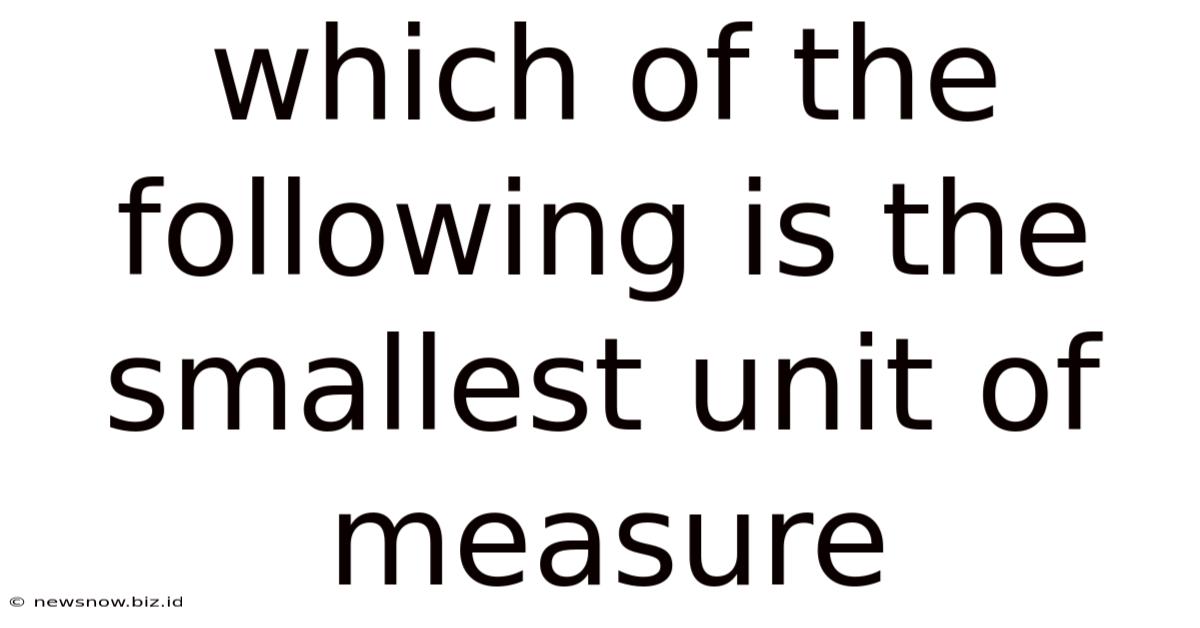Which Of The Following Is The Smallest Unit Of Measure
New Snow
May 10, 2025 · 5 min read

Table of Contents
Which of the Following is the Smallest Unit of Measure? A Deep Dive into Measurement Units
The question, "Which of the following is the smallest unit of measure?" is deceptively simple. The answer hinges on context. There's no single universally smallest unit, as the appropriate unit depends entirely on what you're measuring. We'll explore this complexity, diving deep into various measurement systems and the incredibly tiny units used in different fields, from everyday life to cutting-edge scientific research.
Understanding Measurement Systems
Before we can determine the "smallest" unit, we need to understand the different systems we use for measurement. The two most prominent are:
-
The Metric System (SI Units): This is the internationally recognized system, based on powers of 10. It's remarkably consistent and uses prefixes to indicate multiples or fractions of base units. For example, the base unit of length is the meter (m), and we have kilometers (km), centimeters (cm), millimeters (mm), and micrometers (µm), each differing by a factor of 10.
-
The Imperial System (US Customary Units): Primarily used in the United States, this system is less consistent, utilizing a variety of units and conversions that aren't based on simple mathematical relationships. It includes units like inches, feet, yards, and miles for length; ounces, pounds, and tons for weight; and fluid ounces, pints, quarts, and gallons for volume.
Exploring the Smallest Units in Different Contexts
The concept of the "smallest unit" becomes fascinating when we explore different fields. Let's look at some examples:
1. Length
-
Metric System: While theoretically there's no smallest unit, the femtometer (fm), equal to 10<sup>-15</sup> meters, is often cited as a practical lower limit in many contexts. It's used in nuclear and particle physics to measure distances within atomic nuclei. Beyond femtometers, we enter the realm of subatomic particles, where the classical concept of length becomes less relevant.
-
Imperial System: The smallest practical unit in the Imperial system is arguably the inch, although it can be subdivided into fractions (e.g., 1/16th of an inch). However, even the inch is relatively large compared to the scales at which atoms and subatomic particles exist.
2. Mass
-
Metric System: The attogram (ag), equal to 10<sup>-18</sup> grams, is incredibly small and relevant in fields like biochemistry and molecular biology where the mass of individual molecules or atoms is significant.
-
Imperial System: The smallest practical unit of mass is the grain, which is a very small unit of mass, but it still pales in comparison to the attogram in terms of absolute size. However, for very fine measurements, the grain is frequently subdivided for precision.
3. Time
- Both Systems: Time measurement differs from length and mass. While we can theoretically divide seconds into smaller and smaller units, the smallest measurable unit is constantly evolving with advancements in atomic clocks. Currently, the precision is astonishing, reaching femtoseconds (10<sup>-15</sup> seconds), and even attoseconds (10<sup>-18</sup> seconds) have been explored in extremely specialized contexts. However, reaching even smaller scales remains a challenge in practical timekeeping.
4. Other Units
The concept of "smallest unit" extends beyond the fundamental ones we've discussed. For example:
-
Electric Current: The ampere (A) is the base unit, but extremely small currents are measured using nanoamperes (nA) or even picoamperes (pA).
-
Temperature: While the Kelvin (K) is the base unit, incredibly low temperatures are measured in microkelvins (µK) and nanokelvins (nK) in experiments involving cryogenics and quantum phenomena.
-
Pressure: The Pascal (Pa) is the base unit, but pressures are commonly expressed using microPascals (µPa) and nanoPascals (nPa) in various scientific fields.
The Limits of Measurement and Quantum Mechanics
As we push towards smaller and smaller units, we encounter the fundamental limits imposed by quantum mechanics. At the subatomic level, the very act of measuring a quantity can affect the quantity being measured, introducing uncertainty. Heisenberg's Uncertainty Principle highlights this limitation. The classical concept of precisely measuring a quantity with infinitely small units breaks down.
Practical Considerations and Choosing the Right Unit
Choosing the appropriate unit depends heavily on the context:
-
Scale: The size of the object or phenomenon being measured is crucial. Measuring the length of a building in micrometers would be absurd, while measuring the size of a bacterium in meters would be equally impractical.
-
Precision: The required accuracy of the measurement determines the unit's size. If high precision is needed, smaller units will be essential. For example, measuring the thickness of a human hair requires millimeters or even micrometers, while measuring the distance between cities requires kilometers.
-
Field of Study: Different fields of study employ different units based on their specific requirements and scales of measurement. For instance, astronomers use astronomical units (AU) and light-years, while particle physicists use femtometers and electronvolts.
Conclusion: Context is King
There is no single "smallest unit of measure." The appropriate unit is entirely context-dependent, determined by the scale, precision, and field of study. From the femtometer in particle physics to the attosecond in precision timekeeping, the pursuit of ever-smaller units continues to drive scientific progress, revealing the incredible complexity and subtlety of the universe at its most fundamental level. Understanding the various measurement systems and their respective units is vital for anyone engaging with scientific or technical information. The quest to measure ever smaller quantities constantly pushes the boundaries of human knowledge and technological capabilities, allowing us to explore the universe in ever greater detail. The seemingly simple question of "which is the smallest unit?" therefore unlocks a profound understanding of the limits of measurement and the universe itself.
Latest Posts
Related Post
Thank you for visiting our website which covers about Which Of The Following Is The Smallest Unit Of Measure . We hope the information provided has been useful to you. Feel free to contact us if you have any questions or need further assistance. See you next time and don't miss to bookmark.